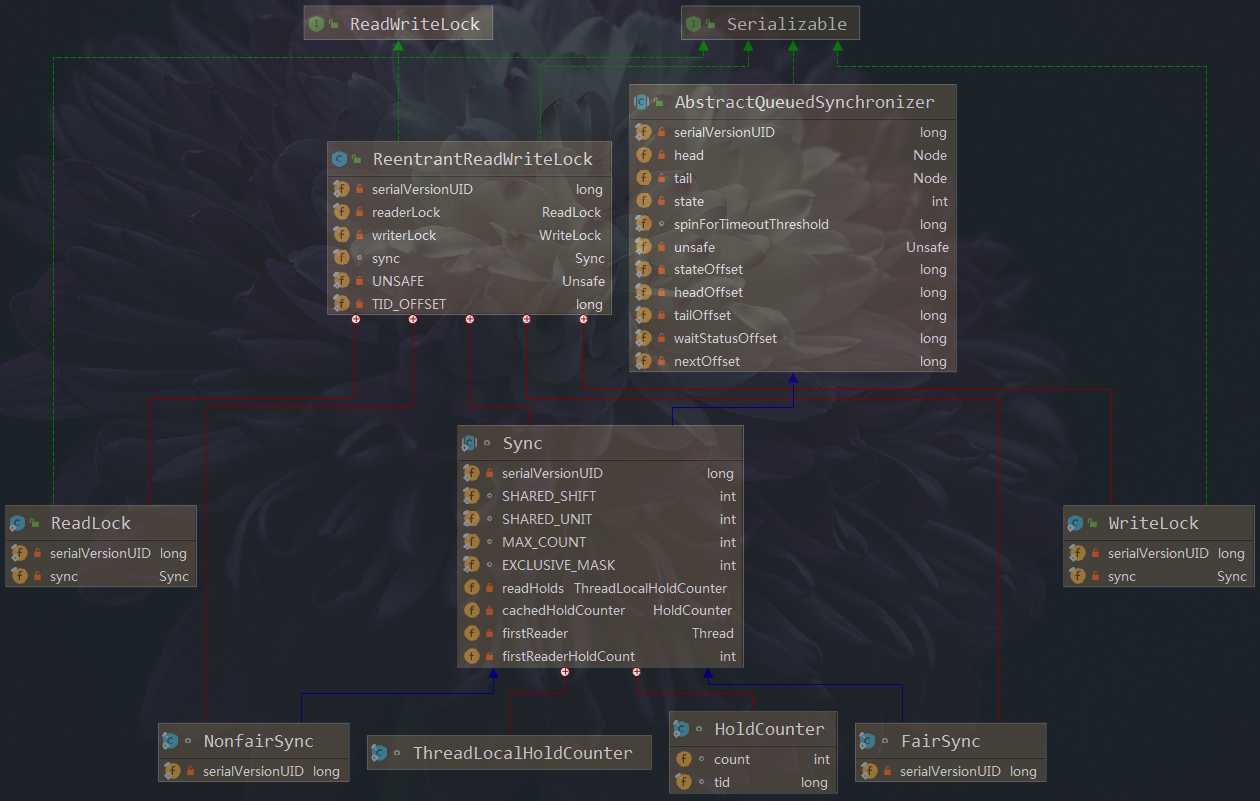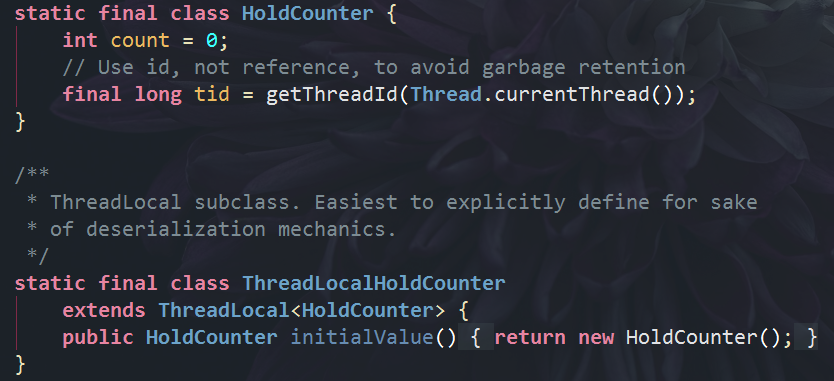1.简介
并发中常用的ReentrantLock,是一种典型的排他锁,这类锁在同一时刻只允许一个线程进行访问,实际上将并行操作变成了串行操作。在并发量大的业务中,其整体效率、吞吐量不能满足实现的需要。而且实际的业务中一般情况是读多于写,多个线程读操作不会改变已经有的数据,不会有数据的一致性问题,而一个写操作就会改变数据,其他的的读操作就可能读到过期的数据。读写锁正是为了这种业务需求而产生的,读写锁在同一时刻可以允许多个读线程访问,但是在写线程访问时,所有的读线程和其他写线程均被阻塞。读写锁维护了一对锁,一个读锁和一个写锁,通过分离读锁和写锁,使得并发性相比一般的排他锁有了很大提升。
读写锁同时支持公平锁和非公平锁,默认实现是非公平锁,非公平锁的吞吐量高于公平锁。
读写锁也支持重入,读锁和写锁的最大重入次数是65535次,这是由int类型本身所能表达的范围区间所决定的。
读写锁能够实现锁降级,它按照先获取写锁、获取读锁再释放写锁的次序执行锁操作,而且写锁能够降级为读锁。
2.ReentrantReadWriteLock的类结构
从UML图可以看出ReentrantReadWriteLock中有多个内部类,这些内部类与ReentrantLock有些类似,都有Sync、NofairSync、FairSync,前者Sync继承于AQS,前者Sync是NofairSync、FairSync的父类。
与 ReentrantLock相比,虽然这3个静态内部类名字相同,但内部却有差异。ReentrantLock是排他锁,又可以说是一种写锁,这三个静态内部类只重写了AQS中的tryAcquire(int) 、tryRelease(int)这两个排他锁相关方法。而ReentrantReadWriteLock是读写锁,要实现排他锁和共享锁这两种锁,Sync、NofairSync、Fair不仅重写SynctryAcquire(int) 、tryRelease(int)方法,另外还重写了AQS中的tryAcquireShared(int)、 tryReleaseShared(int)这两个共享锁相关方法。
ReadLock是表示读锁的静态内部类,它主要委托NofairSync/FairSync中的共享锁相关方法实现的,如"void acquire(int)" "boolean release(int)"等(这两个方法是父类AQS的模板方法,模板方法再去调用自身重写的tryAcquire(int) 、tryRelease(int)方法)。
WriteLock是表示写锁的静态内部类,它主要委托NofairSync/FairSync中的排他锁相关方法实现的,如"void acquireShared(int)" "boolean releaseShared(int)"等。
HoldCounter和ThreadLocalHoldCounter又都是Sync的静态内部类,HoldCounter类的主要作用是记录获一个获取取到共享锁的读线程的重入次数,ThreadLocalHoldCounter继承于线程局部变量ThreadLocal,主要是为每个获取到共享锁的读线程单独维护一个HoldCounter。

Sync中几个值得注意的成员变量
private transient ThreadLocalHoldCounter readHolds; private transient HoldCounter cachedHoldCounter; private transient Thread firstReader = null; private transient int firstReaderHoldCount;
readHolds表示当前线程持有的可重入读锁的数量。 仅在Sync的构造方法和readObject方法中初始化,每当线程的读锁重入计数减少至0时将其移除。
cachedHoldCounter表示最后一个成功获取读锁的线程的重入次数计数器。 在下一个要释放的线程是最后一个要获取的线程的常见情况下,这可以节省在ThreadLocalHoldCounter中查找的时间。
firstReader表示第一个获得读取锁定的线程。firstReader是唯一一个最后一次将读锁重入计数从0更改为1且此后没有释放读取锁的线程; 如果没有这样的线程,则firstReader为null。firstReader使得读取追踪适用于非竞争读锁的效率更高。
firstReaderHoldCount表示第一个成功获取读锁的线程的重入次数。
3.ReadWriteLock的一些方法与使用示例
ReadWriteLock接口只有两个抽象方法,分别获取读锁和读锁。
public interface ReadWriteLock { /** * Returns the lock used for reading. * * @return the lock used for reading */ Lock readLock(); /** * Returns the lock used for writing. * * @return the lock used for writing */ Lock writeLock(); }
另外ReentrantReadWriteLock类还有一些使我们更容易并发编程的一些辅助方法,这些方法都直接委托Sync(或其子类NofairSync/FairSync)去实现。
public int getReadLockCount() { return sync.getReadLockCount(); } public boolean isWriteLocked() { return sync.isWriteLocked(); } public boolean isWriteLockedByCurrentThread() { return sync.isHeldExclusively(); } public int getWriteHoldCount() { return sync.getWriteHoldCount(); } public int getReadHoldCount() { return sync.getReadHoldCount(); }
getReadLockCount()返回成功获取读锁的线程数,即此锁持有的读取锁的数量。。
isWriteLocked()返回写锁是否被某个线程成功获取了。
isWriteLockedByCurrentThread()返回写锁是否被当前线程成功获取了。
getWriteHoldCount()返回当前线程重复获取写锁(重入)的次数。
getReadHoldCount()返加当前线程重复获取读锁(重入)的次数。
使用示例
下面的代码使用HashMap去缓存简称/全称对应关系,addName()方法是写操作,因此使用写锁,getFullName()方法是读操作,因而使用读锁。

package juc; import java.util.HashMap; import java.util.Map; import java.util.concurrent.locks.Lock; import java.util.concurrent.locks.ReadWriteLock; import java.util.concurrent.locks.ReentrantReadWriteLock; public class WRDemo { private final ReadWriteLock wrLock = new ReentrantReadWriteLock(false); private final Lock readLock = wrLock.readLock(); private final Lock writeLock = wrLock.writeLock(); private final Map<String, String> cacheForShortName = new HashMap<>(); public boolean addName(String shortName, String fullName) { final Lock wl = writeLock; wl.lock(); try { if (!cacheForShortName.containsKey(shortName)) { cacheForShortName.put(shortName, fullName); return true; } return false; } finally { wl.unlock(); } } public String getFullName(String shortName) { final Lock rl = readLock; rl.lock(); try { return cacheForShortName.get(shortName); } finally { rl.unlock(); } } public static void main(String[] args) { final WRDemo wrDemo = new WRDemo(); new Thread(() -> { boolean flag = wrDemo.addName("bj", "Beijing"); System.out.println("添加 bj-Beijing:" + (flag ? "成功" : "失败")); }).start(); new Thread(() -> { boolean flag = wrDemo.addName("sh", "Shanghai"); System.out.println("添加 sh-Shanghai:" + (flag ? "成功" : "失败")); }).start(); new Thread(() -> { System.out.println( "上海"+wrDemo.getFullName("sh")); }).start(); new Thread(() -> { System.out.println("上海"+ wrDemo.getFullName("sh")); }).start(); new Thread(() -> { boolean flag = wrDemo.addName("bj", "Beijing"); System.out.println("第二次添加 bj-Beijing:" + (flag ? "成功" : "失败")); }).start(); } }
4.取/存读写状态的设计理念
ReentrantLock使用AQS中的int类型的state成员变量来保存排他锁状态,重入一次使state自增1,每释放一次重入状态state自减1(以前的帖子)。ReentrantReadWriteLock的重入设计理念应该也是基于此。ReentrantLock只需要保存写锁状态,直接使用state成员变量就可以实现,关键在于如何同时保存ReentrantReadWriteLock的读锁状态与写锁状态。其实可以借鉴CPU的标志寄存器的设计理念,将一个变量"按位分割",不同的位范围表示不同的含义。ReentrantReadWriteLock就是将state的高16位表示读状态、低16位表示写状态(int类型4个字节,共32比特位)。

读取读写状态
利用位运算操作,可以分别将高16位和低16位的值取出来。
取低16位的写状态,只需要将state的高16位的所有位设为0即可,根据“0和(1或0)进行按位与操作结果都是0、(0或1)和1进行与操作结果均为其本身”的特点,可以使用按位与操作表达式"state&0x0000FFFF"实现,所以在Sync中exculusiveCount()方法体中有"c&EXCLUSIVE_MASK",而EXCLUSIVE_MASK等于0x0000FFFF。
取高16位的读状态,只需要将state的低16位的抹除即可,可将state无符号右移16位,所以Sync中的sharedCount方法体中有代码"c >>> SHARED_SHIFT"。
static final int SHARED_SHIFT = 16; static final int SHARED_UNIT = (1 << SHARED_SHIFT); static final int MAX_COUNT = (1 << SHARED_SHIFT) - 1; static final int EXCLUSIVE_MASK = (1 << SHARED_SHIFT) - 1; /** Returns the number of shared holds represented in count */ static int sharedCount(int c) { return c >>> SHARED_SHIFT; } /** Returns the number of exclusive holds represented in count */ static int exclusiveCount(int c) { return c & EXCLUSIVE_MASK; }
写入读写状态
假设当前同步状态值为S, 由于低16位表示写锁状态,当写锁状态增加1时,只需要将state设为S+1即可,而高16位表示读锁状态,需要在state的第17位加1,即将state设为S+0x00010000.
因些在尝试获取写锁tryAcquire()方法中有代码“compareAndSetState(c, c + acquires)”,在尝试获取读锁tryAcquireShared方法中有代码“compareAndSetState(c, c + SHARED_UNIT))”
protected final int tryAcquireShared(int unused) { //.... if (!readerShouldBlock() && r < MAX_COUNT && compareAndSetState(c, c + SHARED_UNIT)) {//SHARED_UNIT=0x00010000 } //.... } protected final boolean tryAcquire(int acquires) { //....省略 if (writerShouldBlock() || !compareAndSetState(c, c + acquires))//acquires=1 return false; //....省略 }
5.写锁的获取与释放
写锁的lock()方法实际调用Sync的父类AQS的acquire(int)方法,acquire(int)是模板方法,acquire(int)的主要逻辑在以前的帖子中分析过,我们重点关注被Sync重写的tryAcuqrie(int)方法。
public void lock() { sync.acquire(1); } public final void acquire(int arg) { if (!tryAcquire(arg) && acquireQueued(addWaiter(Node.EXCLUSIVE), arg)) selfInterrupt(); }
尝试获取写锁
tryAcquire的基本逻辑:如果读锁被获取了或写锁被其他线程获取了,那么尝试获取写锁失败。如果在之前当前线程已经获取了写锁,增加重入次数,尝试获取写锁成功。若未有任何读锁、写锁被获取,则进行CAS更新state,
若更新成功,尝试获取写锁成功,返回true,若更新失败,尝试获取写锁失败,返回false.
protected final boolean tryAcquire(int acquires) { /* * Walkthrough: * 1. If read count nonzero or write count nonzero * and owner is a different thread, fail. * 2. If count would saturate, fail. (This can only * happen if count is already nonzero.) * 3. Otherwise, this thread is eligible for lock if * it is either a reentrant acquire or * queue policy allows it. If so, update state * and set owner. */ Thread current = Thread.currentThread(); int c = getState(); int w = exclusiveCount(c);//写锁重入的次数 if (c != 0) {//当前锁至少持有1个读锁或1个写锁(任何情况下最多只能有一个写锁) // (Note: if c != 0 and w == 0 then shared count != 0) /** * 因为 共享锁重入次数+排他锁重入次数 < state ,即 shareCout+ w<c,而又c>0 && w=0, * 那么shareCount>0,当前读锁被某线程获取了,所以这里w=0表示当前读锁被某些线程获取了, * 在读锁被获取了的情况下,不能获取写锁(只有在所有读锁、写锁均补充释放才能获取写锁),返回false。 * * "current != getExclusiveOwnerThread()"为true表明, * 前置条件"w==0"不成立,那么w>0,即写锁已经被某线程获取到了, * 而"current != getExclusiveOwnerThread()"条件本身又表明,当前线程不是获取到写锁的线程 * 所以尝试获取写锁失败,返回false * * 综合起来说,当有读锁被某些线程成功获取或写锁被其他线程成功获取时, * 尝试获取写锁失败,返回false。 */ if (w == 0 || current != getExclusiveOwnerThread()) return false; if (w + exclusiveCount(acquires) > MAX_COUNT) //超出了最大可重入次数,MAX_COUNT=0x0000FFFF throw new Error("Maximum lock count exceeded"); // Reentrant acquire //之前写锁已经被当前线程成功获取,重入次数自增 //尝试获取写锁成功,返回true setState(c + acquires); return true; } //getState=0,当前锁不持有任何读锁、写锁 if (writerShouldBlock() || !compareAndSetState(c, c + acquires)) return false; //cas更新失败,尝试获取写锁失败,返回false //cas更新成功,设置当前线程为独占线程,尝试获取写锁成功,,返回false setExclusiveOwnerThread(current); return true; }
这里与ReentrantLock不同的地方在于多了对读锁是否存在的判断。读锁的读取线程进行读取操作时,它不能主动感知写入操作,如果同时进行读写操作,读入的数据可能是被删除的数据或是过期的数据,读取时不能写入,所以在已有读锁的时候不能再去获取写锁。反过来也是一样,为保证数据的一致性,在有写锁的时候,它要阻塞其他所有的读写操作,不能再去获取任何读锁和写锁。
尝试释放写锁
tryRelease(int)尝试释放锁的基本逻辑和ReentrantLock几乎一样:将重入次数自减,当重入次数为0,将独占线程设为null,返回true,反之返回false.
protected final boolean tryRelease(int releases) { if (!isHeldExclusively()) throw new IllegalMonitorStateException(); int nextc = getState() - releases; boolean free = exclusiveCount(nextc) == 0; if (free) setExclusiveOwnerThread(null); setState(nextc); return free; }
6.读锁的获取与释放
读锁是一个支持重进入的共享锁,它能够被多个线程同时获取,在没有其他写线程访问(或者写状态为0)时,读锁总会被成功地获取,而所做的也只是(线程安全的)增加读状态。如果当前线程已经获取了读锁,则增加读状态。如果当前线程在获取读锁时,写锁已被其他线程获取,则进入等待状态。
尝试获取读锁
tryAcquireShared(int)的主要逻辑:1.如果另一个线程持有写锁定,则失败。 2.否则,此线程符合请求获取读锁的条件,因而进一步询问于根据队列策略是否应该阻塞请求读锁的线程。 如果不是,请尝试按CAS更新state和更新相关重入次数的计数器。此步骤不检查重入获取,这将推迟到完整版本fullTryAcquireShared(Thread)方法,以避免在更典型的非重入情况下检查重入次数的计数。 3.如果第2步失败,表明第2步中应该阻塞读线程或重入次数饱和或CAS失败,此时进入进入fullTryAcquireShared()方法进行完整版的读锁获取重试。
protected final int tryAcquireShared(int unused) { /* * Walkthrough: * 1. If write lock held by another thread, fail. * 2. Otherwise, this thread is eligible for * lock wrt state, so ask if it should block * because of queue policy. If not, try * to grant by CASing state and updating count. * Note that step does not check for reentrant * acquires, which is postponed to full version * to avoid having to check hold count in * the more typical non-reentrant case. * 3. If step 2 fails either because thread * apparently not eligible or CAS fails or count * saturated, chain to version with full retry loop. */ Thread current = Thread.currentThread(); int c = getState(); if (exclusiveCount(c) != 0 && getExclusiveOwnerThread() != current) return -1; //写锁被其他线程成功获取了,尝试获取读锁失败。 int r = sharedCount(c); //所有线程获取读锁的总次数 if (!readerShouldBlock() && r < MAX_COUNT && compareAndSetState(c, c + SHARED_UNIT)) {//不应该阻塞读线程且CAS更新state成功 if (r == 0) { //之前读锁没有被任何线程获取 firstReader = current; //将第一个获取到读锁的线程设为当前线程 firstReaderHoldCount = 1; //第一个获取到读锁的线程重入次数初始为1. } else if (firstReader == current) { //当前线程之前已经获取到读锁,且是第一个获取到读锁的线程 firstReaderHoldCount++;//重入次数自增1 } else { //读锁被某些线程获取了,且当前线程不是第一个获取到读锁的线程 HoldCounter rh = cachedHoldCounter; if (rh == null || rh.tid != getThreadId(current))//当前线程不是最后获取到读锁的线程 //当线程本地变量readHolds中的属于当前线程的HoldCounter赋给cachedHoldCounter cachedHoldCounter = rh = readHolds.get(); else if (rh.count == 0)//当前线程是最后获取到读锁的线程且重入的次数是0 readHolds.set(rh);//将cachedHoldCounter设置为readHolds的当前线程变量 rh.count++;//重入次数自增 } return 1; } //当应该阻塞读线程或重入次数饱和或CAS失败,进入完整版的读锁获取重试 return fullTryAcquireShared(current); }
fullTryAcquireShared()完整版的获取读,可处理tryAcquireShared中CAS失败和被忽略的可重入读
final int fullTryAcquireShared(Thread current) { /* * This code is in part redundant with that in * tryAcquireShared but is simpler overall by not * complicating tryAcquireShared with interactions between * retries and lazily reading hold counts. */ HoldCounter rh = null; for (;;) { int c = getState(); if (exclusiveCount(c) != 0) { if (getExclusiveOwnerThread() != current) return -1; ////写锁被其他线程成功获取了,尝试获取读锁失败。 // else we hold the exclusive lock; blocking here // would cause deadlock. } else if (readerShouldBlock()) { //写锁未被任何线程获取,且不应该阻塞读线程 // Make sure we're not acquiring read lock reentrantly if (firstReader == current) {//确保读锁不会申请重入 // assert firstReaderHoldCount > 0; } else {//当前线程不是第一个获取到读锁的线程 //更新cachedHoldCounter readHolds if (rh == null) { rh = cachedHoldCounter; if (rh == null || rh.tid != getThreadId(current)) { rh = readHolds.get(); if (rh.count == 0) readHolds.remove(); } } if (rh.count == 0) return -1; } } if (sharedCount(c) == MAX_COUNT) throw new Error("Maximum lock count exceeded"); //下面的代码和tryAcquireShared(int)的代码逻辑类似 if (compareAndSetState(c, c + SHARED_UNIT)) { if (sharedCount(c) == 0) { firstReader = current; firstReaderHoldCount = 1; } else if (firstReader == current) { firstReaderHoldCount++; } else { if (rh == null) rh = cachedHoldCounter; if (rh == null || rh.tid != getThreadId(current)) rh = readHolds.get(); else if (rh.count == 0) readHolds.set(rh); rh.count++; cachedHoldCounter = rh; // cache for release } return 1; } } }
fullTryAcquireShared与tryAcquireShared中的代码部分很相似,但由于不使tryAcquireShared与重试和延迟读取“hold counts”之间的交互复杂化,因此整体上更简单。
尝试释放读锁
tryReleaseShared(int),读锁的每次释放均减少读状态,减少的值是(1<<16)。与排他锁的最大不同在于,此处在更新state时,使用CAS更新,而不是无条件更新state,这是从线程安全的的角度考虑的,因为可能有多个读线程同时释放读锁。
protected final boolean tryReleaseShared(int unused) { Thread current = Thread.currentThread(); if (firstReader == current) { //如果当前线程是第一个读锁线程,将其重入次数自减,当重入次数为0时,firstReader赋空 // assert firstReaderHoldCount > 0; if (firstReaderHoldCount == 1) firstReader = null; else firstReaderHoldCount--; } else { //更新cachedHoldCounter readHolds,重入次数自减,当重入次数为0时, // 将当前线程的HoldCounter从线程本地变量readHolds中移除 HoldCounter rh = cachedHoldCounter; if (rh == null || rh.tid != getThreadId(current)) rh = readHolds.get(); int count = rh.count; if (count <= 1) { readHolds.remove(); if (count <= 0) throw unmatchedUnlockException(); } --rh.count; } for (;;) { /** * cas更新state,读锁重入次数减1,不能使用无条件更新state. * 这里是从线程安全的的角度考虑的,因为可能有多个读线程同时释放读锁。 */ int c = getState(); int nextc = c - SHARED_UNIT; if (compareAndSetState(c, nextc)) // Releasing the read lock has no effect on readers, // but it may allow waiting writers to proceed if // both read and write locks are now free. //释放读锁对读线程没有影响,但是如果现在读锁和写锁定均已释放, // 此时可能允许等待的写线程继续执行。 return nextc == 0; } }
